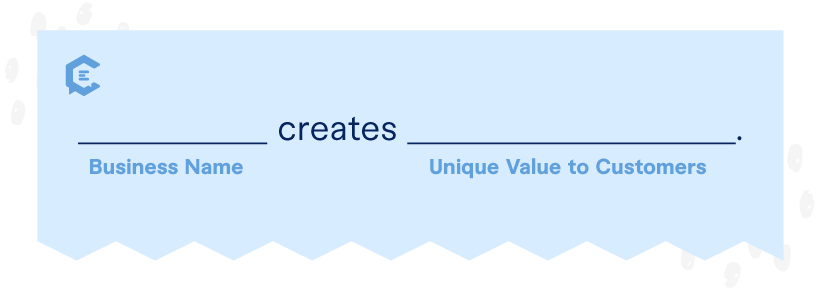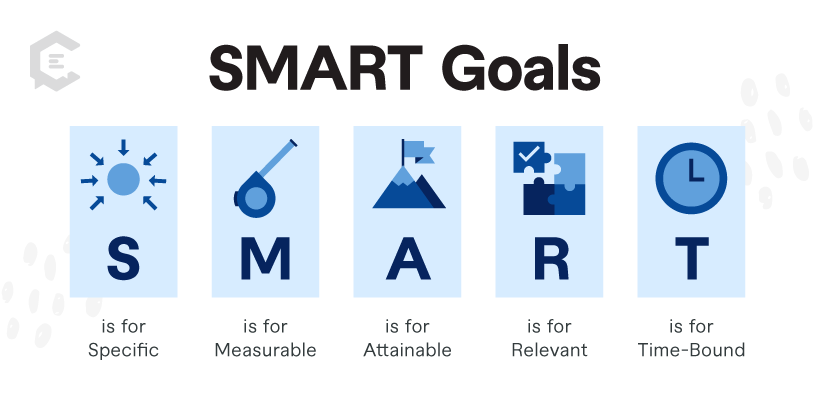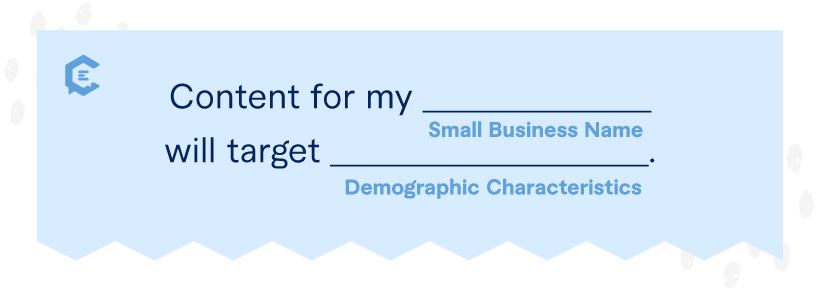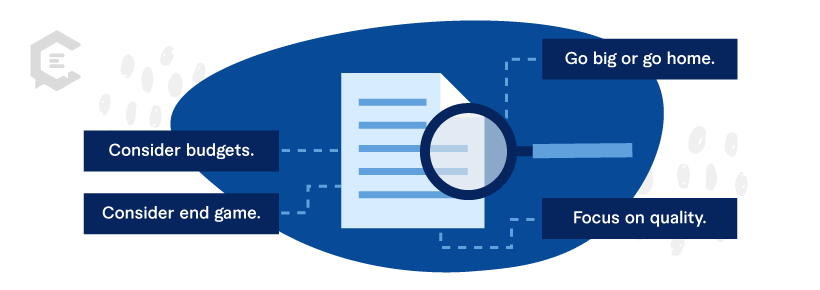Small business owners might think having a content strategy isn’t possible, but guess what? It is. Marketing content has value to small businesses. The challenge is deciding how to turn that value into actionable plans.
We’ll take you through the who, what, where, when, and whys of investing in small business content marketing.
Why should you care about small business content marketing?
Content is an essential tool in an SMB’s arsenal for a number of reasons:
- It can position you as a thought leader and educator by demonstrating expertise on a specific topic in a given industry or sector.
- It can boost your business’ visibility on organic search engines and through social media.
- It can improve consumer trust by serving up solutions to your customer’s pain points.
- It can generate new business leads for your small business.
- It can help foster lasting relationships with your customers.
What are the basics of content strategy?
Your content strategy encapsulates the creation, promotion, and maintenance of your small business content marketing.
It’s often directed by a content strategy document, which is the overarching blueprint you have for creating content, printed or online assets, or information used to attract potential buyers into the consumer journey funnel.
Can SMBs do content marketing?
If you’re questioning if it’s possible to pursue content in your overall marketing mix as a small business owner, the answer is “yes.” Content has a special place for small businesses for a number of reasons:
- It has big returns for little investment: It’s less expensive than advertising and works better. It also has lifetime value, unlike other forms of advertising. For instance, with paid ads, a person sees the ad once and only once. With content, it repeatedly reaches audiences. So the investment in the content may be more far-reaching than other forms of marketing.
- It’s effective: Small business content marketing reaches audiences at the right time. Unlike other forms of marketing, content consumption is an opt-in process, meaning readers take an action to engage with your brand.
- It’s sharable: If you need to fill up your social media content calendar, there’s no better place for that than with brand content! Content can help encourage new followers, boost your engagement, and make your business a household name. And if your content is good, it could even go viral, costing you nothing to reach hundreds, if not thousands.
How to create a small business content marketing strategy
Now that you know it’s possible to create content as a small business, you should take a specific approach to do it. Your content strategy answers “How will my small business succeed?” by setting constraints for when your small business will create and distribute.
It sets a framework for:
- Who to create content for
- What content to create
- What you’re hoping to achieve with your content
- Where the content will live
- When content will be published and shared
- Why people should care about your content
- How you will measure the success of your campaigns
If you’ve created a small business strategy document, you’re one step ahead as many of the steps in it mimic a content strategy.
Vision
Your company vision summarizes your business’s desired future state. It’s a statement that affirms where you want your business to go in a given time frame. Here’s an example:
Mission
Your mission statement should summarize what your small business exists to accomplish. Similar to vision, it’s aspirational. But it is more specific than that. Here’s an example:
Goals
Your goals are concrete outcomes that support your mission. It’s wise to consider the “SMART” goal acronym when setting content goals for your small business, which means they should be:
- Specific: Directed at a particular outcome
- Measurable: Your progress can be objectively tracked
- Attainable: The goal isn’t too easy or too complex — based on your resources within your small business, it’s achievable
- Results-oriented: The goal is centered around your small business’ “why” (why you exist)
- Time-bound: Giving a goal a set time frame to set structure and urgency
Here are a few examples of content marketing goals:
- “In [YEAR], improve product recognition by [PERCENTAGE].”
- “In [QUARTER], gain [PERCENTAGE] of the market share in [GEOGRAPHIC ZONE] in [INDUSTRY].”
- “In [YEAR], improve customer retention by [PERCENTAGE].”
Audience
Before you write content, you should target who it’s for. When creating a content strategy, you shouldn’t set your target to all people. As a small business owner, your market research resources may be limited, but you can keep it simple by doing existing customer surveys and even interviews. Here’s an example of defining the right audience for a content strategy
Tactics
Small business content marketing goals can seem like lofty ambitions, but tactics actualize your big aspirations. This is where the practical application begins.
Tactics answer the “how” of accomplishing a content goal. They are the practical things you’ll do each day and are materialized in actual content marketing assets. Here are some small business content marketing tactics:
- Advertorials or native content
- Blog posts
- Digital newsletters
- eBooks or Whitepapers
- Infographics
- Interactive tools
- Landing pages and microsites
- Social content
- Podcasts
- Webinars
- Live video
- Printed newsletters or magazines
- Mobile apps and SMS messaging
- Website content
- Resource guides
Pro tip: While some small business owners have the time and will to create these types of assets, not all do. Here’s where ClearVoice’s content creation comes into play. With our help, you can power your content marketing with fully managed content creation by freelance teams in 200+ business categories. With our help, you can take your small business’ content projects to enterprise scale.
Distribution
Your work doesn’t stop once your small business’ content assets are published. Your content strategy should have a designated home for each of the content assets you create, then a promotional plan that complements it.
Measurement
Like any form of marketing, you can’t shoot from the hip and expect to understand your results. To this end, have a plan in place for measurement. Here are a few key content performance indicators you should consider:
- Traffic (Users, page views, and unique page views)
- Conversions
- Social engagement
- SEO rank
- Domain authority
What should SMBs consider while creating content?
Small businesses have special nuances to be mindful of while when it comes to content creation and strategy. Here are some major small business content marketing considerations:
Go big or go home
When you create content as a small business, you have to be holistic about it. You can’t just create one content asset and hope it fulfills your content goal(s). Your strategy should encompass a big picture versus one content asset at a time.
Consider budgets
Frankly, small businesses don’t have the budgets that large enterprises do. While you want to engage in content in the coming months or years, you might not know how much to allocate for it. Forbes contributor Aaron Agius says:
“Although these figures will vary across industries, a good rule of thumb that many marketers recommend is to designate 25% to 30% of your marketing budget to content marketing. So if you currently have a marketing budget of $100,000, that translates to around $25,000 to $30,000. If you’re just starting out, I recommend aiming for the lower end of this range and increasing your spending as you continue testing and you determine what works best for your brand.”
Focus on quality
Your content strategy should support the notion that your business repeatedly creates high-quality content. Erica Kissane’s book, Elements of Content Strategy, describes a few qualities of good content as:
- Appropriate: It supports the audience’s needs and desires.
- Useful: It fulfills a specific purpose.
- User-focused: It’s focused on the reader or visitor, not you or anyone else.
- Consistent: Every content asset reflects the voice of your small business.
- Concise: It’s to the point.
Consider the end game
Your content strategy should focus on longitudinal health and sustainability. “It is more of a slow burn approach than a fast and aggressive ad to a customer who knows nothing about you,” says Audisocket contributor Amy Johnson.
But, organic content marketing and paid marketing both have a place in your small business content marketing mix. One is a quick win to attract attention, while it doesn’t have lifetime value.
Good content, on the other hand, is an SEO factor that helps rank your web pages on search engines over a long time. If you have a high search result, you will continue to produce organic (free) traffic to your site for years to come.
How can ClearVoice help?
At ClearVoice, content is the name of our game. We have expert content strategists to drive your small business’ content strategy from start to finish and writers galore to help you put your content plan into action.
Let ClearVoice be your talent partner for all your ongoing content marketing and publication needs, with vetted freelancers to help produce content for your brand.









